Top Rankings
Glenpool School District ranks among the top 20% of public school district in Oklahoma for:
Category
Attribute
Graduation Rate
Highest graduation rate (Top 10%)
Diversity
Most diverse schools (Top 1%)
Community Size
Largest student body (number of students) (Top 1%)
For the 2025 school year, there are 5 public schools serving 2,814 students in Glenpool School District. This district's average testing ranking is 6/10, which is in the top 50% of public schools in Oklahoma.
Public Schools in Glenpool School District have an average math proficiency score of 29% (versus the Oklahoma public school average of 25%), and reading proficiency score of 25% (versus the 27% statewide average).
Minority enrollment is 59% of the student body (majority American Indian and Hispanic), which is more than the Oklahoma public school average of 56% (majority Hispanic and American Indian).
Overview
This School District
This State (OK)
# Schools
5 Schools
1,794 Schools
# Students
2,814 Students
721,016 Students
# Teachers
176 Teachers
43,565 Teachers
Student : Teacher Ratio
16:1
16:1
District Rank
Glenpool School District, which is ranked within the top 50% of all 533 school districts in Oklahoma (based off of combined math and reading proficiency testing data) for the 2021-2022 school year.
The school district's graduation rate of 90-94% has increased from 80-84% over five school years.
Overall District Rank
#225 out of 538 school districts
(Top 50%)
(Top 50%)
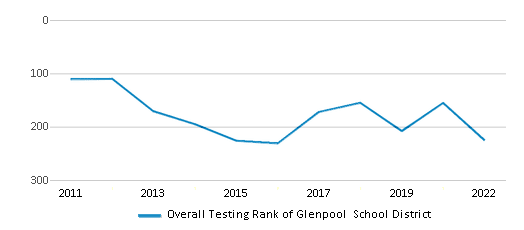
Math Test Scores (% Proficient)
28%
25%
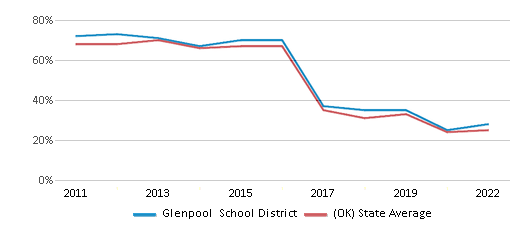
Reading/Language Arts Test Scores (% Proficient)
25%
27%
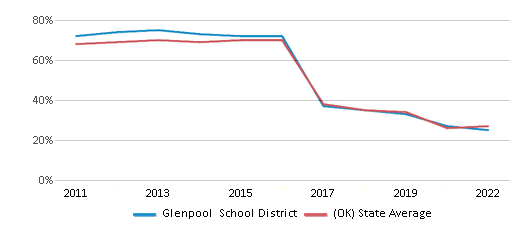
Science Test Scores (% Proficient)
34%
31%
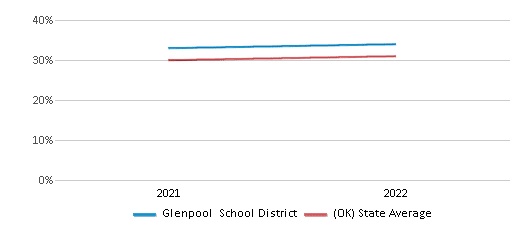
Graduation Rate
(20-21)90-94%
78%
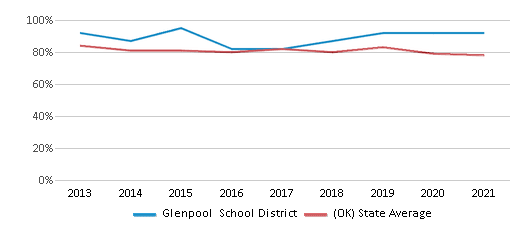
Students by Ethnicity:
Diversity Score
0.76
0.73
# American Indian Students
455 Students
78,002 Students
% American Indian Students
16%
11%
# Asian Students
291 Students
16,351 Students
% Asian Students
10%
2%
# Hispanic Students
307 Students
146,732 Students
% Hispanic Students
11%
20%
# Black Students
75 Students
57,572 Students
% Black Students
3%
8%
# White Students
1,145 Students
320,142 Students
% White Students
41%
44%
# Hawaiian Students
3 Students
3,156 Students
% Hawaiian Students
n/a
1%
# Two or more races Students
538 Students
98,894 Students
% of Two or more races Students
19%
14%
Students by Grade:
# Students in PK Grade:
159
38,038
# Students in K Grade:
184
49,325
# Students in 1st Grade:
208
51,638
# Students in 2nd Grade:
205
51,822
# Students in 3rd Grade:
219
51,866
# Students in 4th Grade:
224
51,270
# Students in 5th Grade:
203
51,780
# Students in 6th Grade:
218
52,317
# Students in 7th Grade:
191
53,730
# Students in 8th Grade:
224
55,226
# Students in 9th Grade:
218
57,588
# Students in 10th Grade:
187
55,440
# Students in 11th Grade:
190
52,900
# Students in 12th Grade:
184
48,076
# Ungraded Students:
-
-
District Revenue and Spending
The revenue/student of $9,929 in this school district is less than the state median of $10,983. The school district revenue/student has declined by 5% over four school years.
The school district's spending/student of $9,991 is less than the state median of $10,957. The school district spending/student has declined by 5% over four school years.
Total Revenue
$28 MM
$7,919 MM
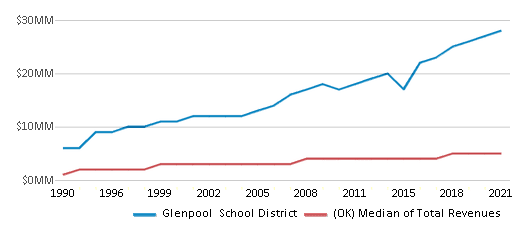
Spending
$28 MM
$7,900 MM
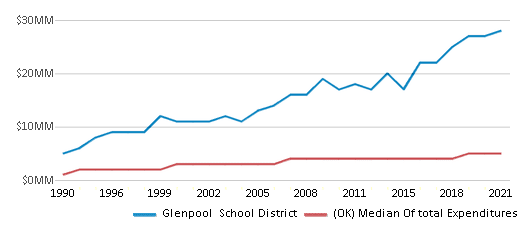
Revenue / Student
$9,929
$10,983
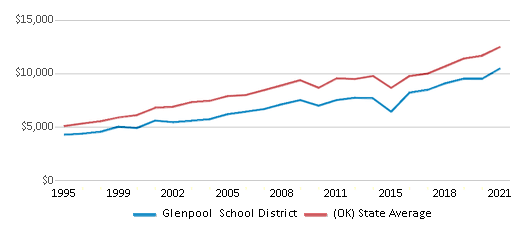
Spending / Student
$9,991
$10,957
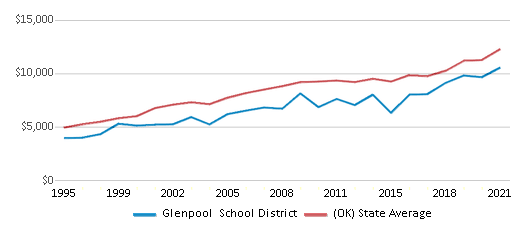
Best Glenpool School District Public Schools (2025)
School
(Math and Reading Proficiency)
(Math and Reading Proficiency)
Location
Grades
Students
Rank: #11.
Glenpool High School
(Math: 20-24% | Reading: 40-44%)
Rank:
Rank:
7/
Top 50%10
140 W 141st
Glenpool, OK 74033
(918) 322-9500
Glenpool, OK 74033
(918) 322-9500
Grades: 9-12
| 779 students
Rank: #22.
Glenpool Elementary School
(Math: 42% | Reading: 26%)
Rank:
Rank:
7/
Top 50%10
140 W 141st
Glenpool, OK 74033
(918) 322-9500
Glenpool, OK 74033
(918) 322-9500
Grades: 1-4
| 856 students
Rank: #33.
Glenpool Intermediate School
(Math: 30% | Reading: 24%)
Rank:
Rank:
6/
Top 50%10
140 W 141st
Glenpool, OK 74033
(918) 322-9500
Glenpool, OK 74033
(918) 322-9500
Grades: 5-6
| 421 students
Rank: #44.
Glenpool Middle School
(Math: 17% | Reading: 16%)
Rank:
Rank:
3/
Bottom 50%10
140 W 141st
Glenpool, OK 74033
(918) 322-9500
Glenpool, OK 74033
(918) 322-9500
Grades: 7-8
| 415 students
Rank: n/an/a
140 W 141st
Glenpool, OK 74033
(918) 322-9500
Glenpool, OK 74033
(918) 322-9500
Grades: PK-K
| 343 students
Frequently Asked Questions
How many schools belong to Glenpool School District?
Glenpool School District manages 5 public schools serving 2,814 students.
What is the rank of Glenpool School District?
Glenpool School District is ranked #239 out of 533 school districts in Oklahoma (top 50%) based off of combined math and reading proficiency testing data for the 2021-2022 school year. This district ranks in the top 20% of Oklahoma school districts for: Highest graduation rate (Top 10%), Most diverse schools (Top 1%) and Largest student body (number of students) (Top 1%)
What is the racial composition of students in Glenpool School District?
41% of Glenpool School District students are White, 19% of students are Two or more races, 16% of students are American Indian, 11% of students are Hispanic, 10% of students are Asian, and 3% of students are Black.
What is the student/teacher ratio of Glenpool School District?
Glenpool School District has a student/teacher ratio of 16:1, which is lower than the Oklahoma state average of 17:1.
What is Glenpool School District's spending/student ratio?
The school district's spending/student of $9,991 is less than the state median of $10,957. The school district spending/student has declined by 5% over four school years.
Recent Articles

Year-Round Or Traditional Schedule?
Which is more appropriate for your child? A year-round attendance schedule or traditional schedule? We look at the pros and cons.

Why You Should Encourage Your Child to Join a Sports Team
Participating in team sports has a great many benefits for children, there is no doubt. In this article you will learn what those benefits are.

White Students are Now the Minority in U.S. Public Schools
Increasing birth rates among immigrant families from Asia and Central and South America, combined with lower birth rates among white families, means that for the first time in history, public school students in the United States are majority-minority. This shift in demographics poses difficulties for schools as they work to accommodate children of varying language abilities and socio-economic backgrounds.





